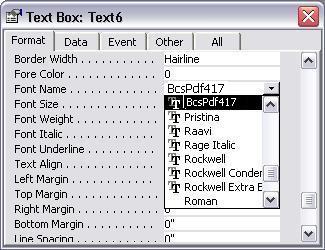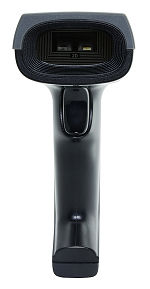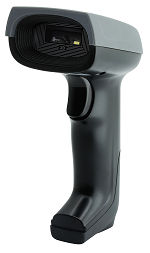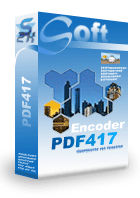PDF417 Barcode Font
Keywords:
PDF417 Barcode, Micro PDF417, ISO/IEC 15438:2006, ISO/IEC 24728:2006
PDF417 is a 2D barcode symbology. It has a unique structure and large data capacity.
PDF417 empowers you to encode over 1000 alpha-numeric characters within one symbol, both ASCII and extended ASCII characters.
Therefore, PDF417 barcode is a good solution for encoding large quantities of data in one symbol.
PDF417 uses Reed-Solomon-algorithm for error correction. The higher security level is, the larger size of pdf417, the less decipher error chance. If not specified, software will use default level 0. Level 0 means automatic security selection.
You can integrate Barcodesoft PDF417 software with MS Excel, MS Access and Crystal Reports.
The software also has a solution for MicroPDF417 encoding.
crUFLbcs.dll has a IPDF417 interface. IPDF417 interface has two methods: Encode and EncodeCR.
crUFLbcs.dll also has a IMicroPDF417 interface. IMicroPDF417 interface has two methods: Encode and EncodeCR.
Encode accepts only one parameter as input. it returns PDF417 in hex codes. After using the bcspdf417 font, returned hex codes will become a PDF417 barcode.
Encode(strToEncode)
EncodeCR accepts seven parameters as input. It returns PDF417 in hex codes. After using the bcspdf417 font, returned hex codes will become a PDF417 barcode.
EncodeCR(strToEncode, index, MaxRow, FixedColumn, Security, CompactionMode, Truncated)
The first parameter is a string to encode.
The second parameter is an integer variable. When set to zero, it returns all codewords. When it is 1, it returns the first 250 codewords. When it is 2, it returns the second 250 codewords. And so on.
The third parameter is an integer variable. It sets the Max-Rows of a PDF417 barcode.
The fourth parameter is an integer variable. It sets the column number of a PDF417 barcode.
The fifth parameter is an integer variable. It sets the security level of a PDF417 bar code. When set to zero, it means automatic security selection. Security level ranges from zero to nine.
The sixth parameter is an integer variable. It sets the compaction mode of PDF417. Zero means mixed mode, 1 means Text Mode, 2 means Numeric Mode, and 3 means Binary Mode.
The seventh parameter is a boolean variable. It sets the PDF417’s truncated option.
This is the pricing list of Barcodesoft PDF417 barcode software:
| License | Single User | 5-User | 10-User | Site | Corporate | Developer | 5-Developer | 10-Developer | Unlimited Developer |
|---|---|---|---|---|---|---|---|---|---|
| Price | CAD299 | CAD399 | CAD599 | CAD799 | CAD999 | CAD1199 | CAD1399 | CAD1999 | CAD2999 |
Generate PDF417 Barcode in Crystal Reports
1. Right click command prompt and run command prompt as administrator.
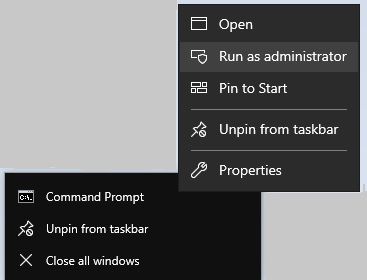
Type in the following commands to register cruflbcs.dll
cd "C:\Program Files (x86)\Common Files\Barcodesoft\FontUtil"
regsvr32.exe cruflbcs.dll

To register 64-bit DLL, please type in the following commands
cd "C:\Program Files (x86)\Common Files\Barcodesoft\FontUtil"
%systemroot%\System32\regsvr32.exe cruflbcs_x64.dll
If you see the following Window pop up, your registration was successful.
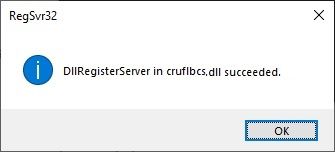
2. Open your crystal report. Right click Formula Fields, choose "New..." from the context menu.
Type in "pdf417" in the Name textbox, then click "Use Editor".
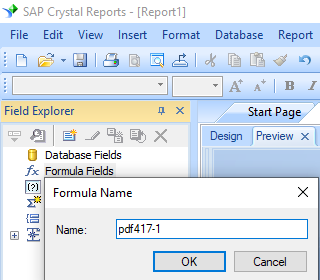
3. From Functions List ==> Additional Functions ==> COM and .NET UFLs (u212com.dll), double click to choose "BCSPDF417EncodeCR" function as shown below.
Please type in the database field as parameter for PDF417 formula. And click "Save" button to save PDF417 formula field.
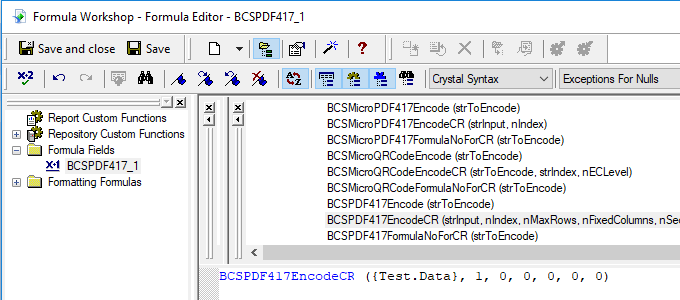
4. Create multiple formula fields as listed below if returned value of BCSPDF417FormulaNoForCR({Test.Data}) is larger than one.
BCSPDF417EncodeCR({Test.Data}, 1, 0, 0, 0, 0, 0)
BCSPDF417EncodeCR({Test.Data}, 2, 0, 0, 0, 0, 0)
BCSPDF417EncodeCR({Test.Data}, 3, 0, 0, 0, 0, 0)
The first parameter is string to encode.
The second parameter in the formula is index.
The other parameters are MaxRow, FixedColumn, Security, Compaction Mode and Truncated option.
For detailed explanations of each parameter, please refer to readme file.
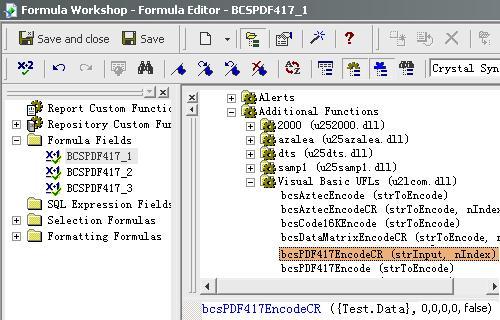
5. Insert a text object in your report. Drag and drop all PDF417 formula fields to your crystal report. You will see some hex codes. Don't worry! You haven't applied PDF417 barcode font yet.
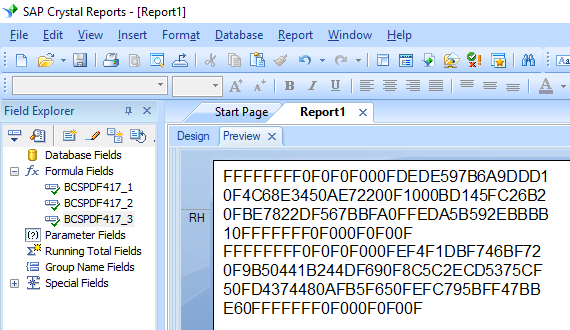
6. Please right click text object in your report and choose "Format Field" from context menu. Then choose "BcsPDF417" as font.
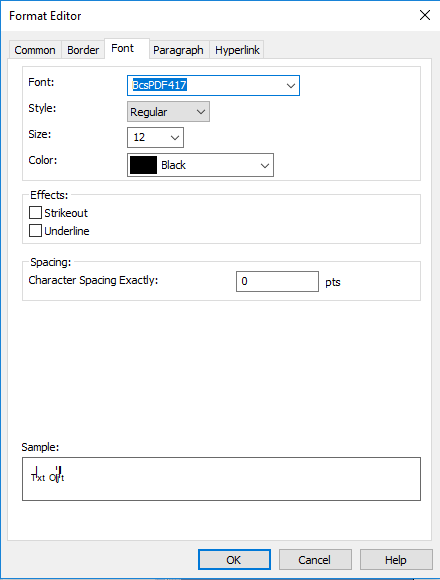
7. Click OK button. You will see PDF417 barcode in your report.
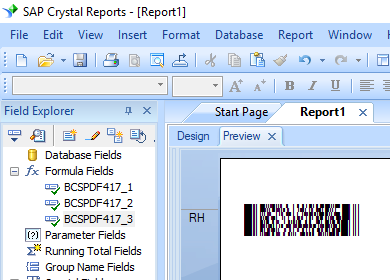
Generate PDF417 Barcode in MS Excel
1. Right click command prompt and run command prompt as administrator.

Type in the following commands to register cruflbcs.dll
cd "C:\Program Files (x86)\Common Files\Barcodesoft\FontUtil"
regsvr32.exe cruflbcs.dll

To register 64-bit DLL, please type in the following commands
cd "C:\Program Files (x86)\Common Files\Barcodesoft\FontUtil"
%systemroot%\System32\regsvr32.exe cruflbcs_x64.dll
If you see the following Window pop up, your registration was successful.

2. Start Microsoft® Excel®.
If you are using Excel 2000 or 2003, click menu ===> Tools ==> Macro ===> Security. Choose Low security level.

If you are using Excel 2007 / 2010 / 2013 / 2016 / 2019, click the Microsoft Office Button.
![]()
![]()
![]()
Then click Excel Options, choose Trust Center. In the Macro Settings category, under Macro Settings, choose "Enable all macros" as shown below.

3. Press ALT + F11 to open Microsoft® Visual Basic editor.
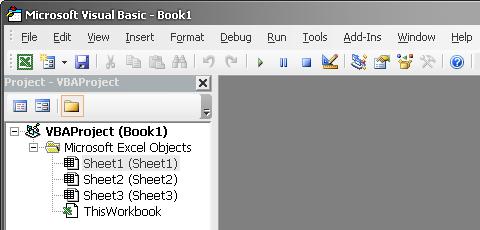
4. From Visual Basic editor, choose menu Tools ===> References. It will popup a dialog. Click Browse button and choose cruflbcs.dll from your working folder.
Usually it's under C:\Program File (x86)\CommonFiles\Barcodesoft\Fontutil folder.
Click the checkbox beside crUFLBcs 4.0 Type Library as shown below. Then click OK button.
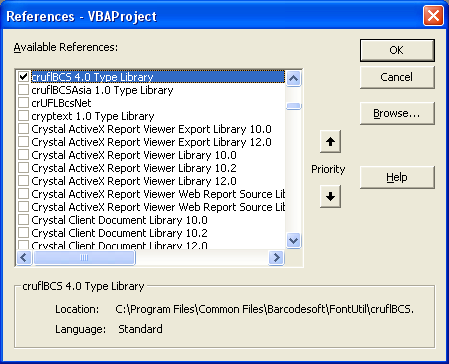
5. Press Ctrl+M, it will popup a dialog, choose barcodesoft.bas under C:\Program File (x86)\CommonFiles\Barcodesoft\Fontutil folder. Then click "Open".
If you don't find barcodesoft.bas, please download it from PDF417.
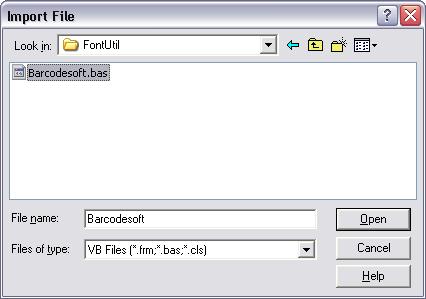
6. Close Visual Basic and go back to your spreadsheet. Now, you can use the following macro to encode data: pdf417. When you have lots of data to process, you can just copy and paste the pdf417 macro to the whole column / row of data. All your PDF417 barcodes will be ready immediately.
=pdf417(xxx)
Please use cell reference to replace xxx in the formulas as shown below.

7. Right click Cell B1, choose Format Cell from context menu as shown below.

8. Click Font tab and choose BcsPDF417S as font typeface as shown below.
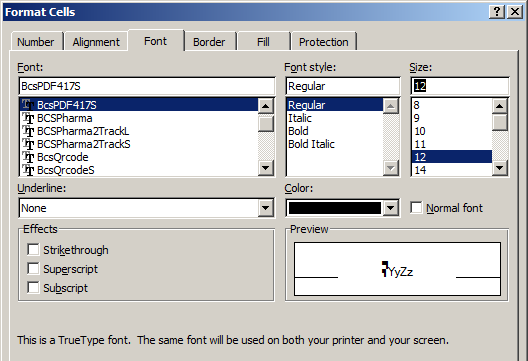
9. Click Alignment tab and select "wrap text" as shown below.
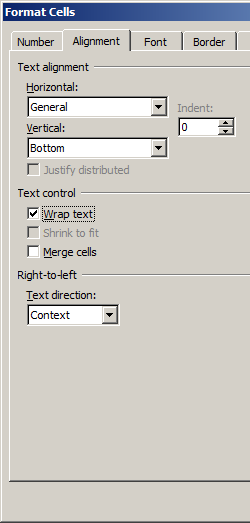
10. Click OK and you should be able to see PDF417 barcode in your Excel spreadsheet now. There might be a small gap between different lines of PDF417. However, this won't be an issue when you scan the printed PDF417 because bcsDatamatrixS true type font is designed to reduce this gap to mininum.
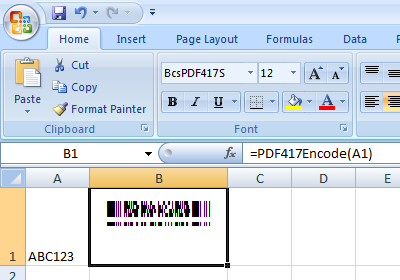
Generate PDF417 Barcode in MS Access
1. Right click command prompt and run command prompt as administrator.

Type in the following commands to register cruflbcs.dll
cd "C:\Program Files (x86)\Common Files\Barcodesoft\FontUtil"
regsvr32.exe cruflbcs.dll

To register 64-bit DLL, please type in the following commands
cd "C:\Program Files (x86)\Common Files\Barcodesoft\FontUtil"
%systemroot%\System32\regsvr32.exe cruflbcs_x64.dll
If you see the following Window pop up, your registration was successful.

2. Start Microsoft® Access®.
If you are using Access 2000 or 2003, click menu ===> Tools ==> Macro ===> Security. Choose Low security level.

If you are using Access 2007 / 2010 / 2013 / 2016 / 2019, click the Microsoft Office Button.

![]()
![]()
Then click Access Options, choose Trust Center. In the Macro Settings category, under Macro Settings, choose "Enable all macros" as shown below.
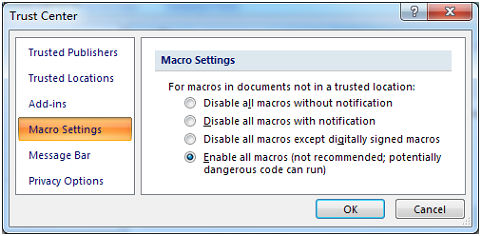
3. Press ALT + F11 to open Microsoft® Visual Basic editor.
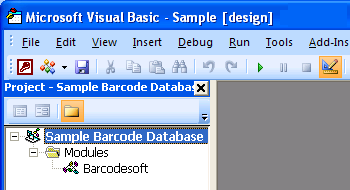
4. From Visual Basic editor, choose menu Tools ===> References. It will popup a dialog. Click Browse button and choose cruflbcs.dll from your working folder.
Usually it's under C:\Program File (x86)\CommonFiles\Barcodesoft\Fontutil folder.
Click the checkbox beside crUFLBcs 4.0 Type Library as shown below. Then click OK button.

5. Press Ctrl+M, it will popup a dialog, choose barcodesoft.bas under C:\Program File (x86)\CommonFiles\Barcodesoft\Fontutil folder. Then click "Open".
If you don't find barcodesoft.bas, please download it from pdf417.

6. Close Visual Basic and go back to your Access database. Now, create a report in Design view and type in one of the following macros in the field where you want to show PDF417 barcode before apply font typeface:
=pdf417([data.code])
=micropdf417([data.code])
Please notice that 'data' is the Table name, 'code' is the Field name.
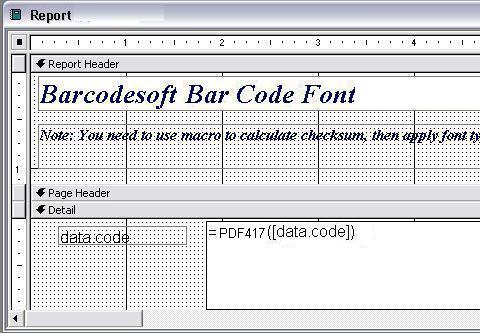
7. Right click the field you want to display pdf417 barcode. Choose Properties from context menu. Apply one of the appropriate font typefaces to the field, such as BcsPDF417.
